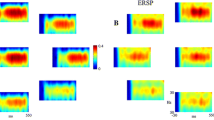Conclusions
-
1.
With the averaging of the EEG of the entire interimpulse interval in the procedure investigating the habituation of auditory evoked potentials (EPs) in healthy individuals and endogenous depression patients in the averaged EP-EEG, a “rhythmical wave process” (RWP) appeared, especially pronounced in the patient group.
-
2.
The RWP appeared or became more marked in successive averagings across the 10 realizations completing each series of 30 stimuli. It significantly predominated in the patients, often making more difficult the identification of the EPs, and not infrequently was maintained in the averages of all 120 realizations, with an amplitude comparable to the amplitude of the basic components of the EP or even exceeding it. A reliable correlation of the parameters of the RWP with the indices of melancholic mood was identified in both the patients and the well subjects.
-
3.
The RWP may be regarded as a special manifestation of perceptual defense in individuals in whom “internal distraction” as the result of depression mood leads to the engagement of mechanisms of active isolation from the external world.
Similar content being viewed by others
Literature cited
G. Yu. Volynkina and N. F. Suvorov, The Neurophysiological Structure of the Emotional States of Man [in Russian], Nauka, Leningrad (1981).
A. M. Ivanitskii, Brain Mechanisms of Signal Evaluation [in Russian], Meditsina, Moscow (1976)
E. I. Korchinskaya and V. N. Krasnov, “Changes in electroencephalographic indices in different variants of the depressions,” Tr. Mosk. Nauchno-Issled Inst. Psikiatr. MZ RSFSR, Vol. 91, Moscow (1980), p. 67.
É. A. Kostandov, “Neurophysiological mechanisms of unconscious mental phenomena,” Usp. Fiziol. Nauk,12, 4, 3 (1981).
V. V. Loginov, I. P. Leshchinskaya, and L. P. Latash, “The habituation of auditory evoked potentials and emotional state,” Zh. Vyssh. Nervn. Deyat.,37, 3, 414 (1987).
S. M. Osovets, D. A. Ginzburg, V. S. Gurfinekl', et al., “Electrical activity of the brain: mechanisms and interpretation,” Usp. Fiziol. Nauk,14, 1, 103 (1983).
É. M. Rutman, Evoked Potentials in Psychology and Psychophysiology [in Russian], Nauka, Moscow (1979).
E. Basar, EEG-Brain Dynamics, Elsevier, Amsterdam (1980).
E. Basar, C. Basar-Eroglu, B. Rosen, and A. Schütt, “A new approach to endogenous event-related potentials in man: relation between EEG and P300-wave,” Int. J. Neurosci.,24, 1, 1 (1984).
M. E. Dawson, A. M. Schell, and J. J. Catania, “Automatic correlates of depression and clinical improvement following electroconvulsive shock therapy,” Psychophysiology,14, 6, 569 (1977).
F. Denoth, R. Zappoli, C. Navona, and A. Ragazzoni, “Posterior alpha activity during vertex-CNV formation under different stimulating conditions,” in: Brain and Information: Event-Related Potentials, eds. R. Karrer, J. Cohen, and E. Tueting, Vol. 425, Ann. Acad. Sci., New York (1984), p. 177.
M. H. Erdelyi, “A new look at the new look: perceptual defence and vigilance,” Psychol. Rev.,81, 1, 1 (1974).
E. M. Glaser and D. S. Ruchkin, Principles of Neurobiological Signal Analysis, Academic Press, New York (1976).
H. Heimann, “Clinical, evaluation, self-rated mood, and psychophysiological reactivity in depressing syndromes,” Progr. Neuropsychopharmacol.,4, 4–5, 379 (1980).
H. Heimann and H. Giedke, “Psychophysiology of anxiety, fear and phobia,” Progr. Neuropsychopharmacol.,5, 2, 167 (1981).
N. Kawabata, “Nonstationary power spectrum of the photic alpha blocking,” Kybernetik,12, 1, 40 (1972).
L. K. Morrell, “Some characteristics of stimulus provoked alpha activity,” EEG Clin. Neurophysiol.,21, 6, 552 (1966).
T. Mulholland and D. Goodman, “Hypothesis of background EEG,” in: Rhythmic EEG Activities and Cortical Functioning, eds. G. Pfurtscheller et al., Elsevier, Amsterdam (1980), p. 277.
T. Mulholland and S. Runnals, “Increased occurrence of EEG alpha during increased attention,” J. Psychol.,54, Pt. 2, 317 (1962).
U. Neisser, Cognition and Reality, Freeman, San Francisco (1976).
D. Papakostopoulos, H. J. Crow, and P. Newton, “Spatiotemporal characteristics of intrinsic and evoked event-related potentials in the human cortex,” in: Rhythmic EEG Activities and Cortical Functioning, eds. G. Pfurtscheller et al., Elsevier, Amsterdam (1980), p. 179.
C. Parvin, F. Torres, and E. A. Johnson, “Synchronization of single evoked response components: estimation and interpretation of reproducibility measures,” in: Rhythmic EEG Activities and Cortical Functioning, eds. G. Pfurtscheller et al., Elsevier, Amsterdam (1980), p. 203.
G. Perris, “EEG techniques in the measurement of the severity of depressive syndromes,” Neuropsychobiology,1, 1, 16 (1975).
G. Pfurtscheller and A. Aranibar, “Voluntary movement ERD: normative studies,” in: Rhythmic EEG Activities and Cortical Functioning, eds. G. Pfurtscheller et al., Elsevier, Amsterdam (1980), p. 151.
J. Ttasuno, J. Mori, H. Achida, and E. Maru, “Changes in alpha band activities during alpha blocking induced by flash stimulation,” in: Rhythmic EEG Activities and Cortical Functioning, eds. G. Pfurtscheller et al. Elsevier, Amsterdam (1980), p. 249.
Author information
Authors and Affiliations
Additional information
Translated from Zhurnal Vysshei Nervnoi Deyatel'nosti imeni I. P. Pavlova, Vol. 37, No. 5, pp. 866–874, September–October, 1988.
Rights and permissions
About this article
Cite this article
Loginov, V.V., Leshchinskaya, I.P. & Latash, L.P. EEG of interimpulse intervals during habituation of auditory evoked potentials in depressed moods. Neurosci Behav Physiol 18, 401–408 (1988). https://doi.org/10.1007/BF01193886
Received:
Issue Date:
DOI: https://doi.org/10.1007/BF01193886




